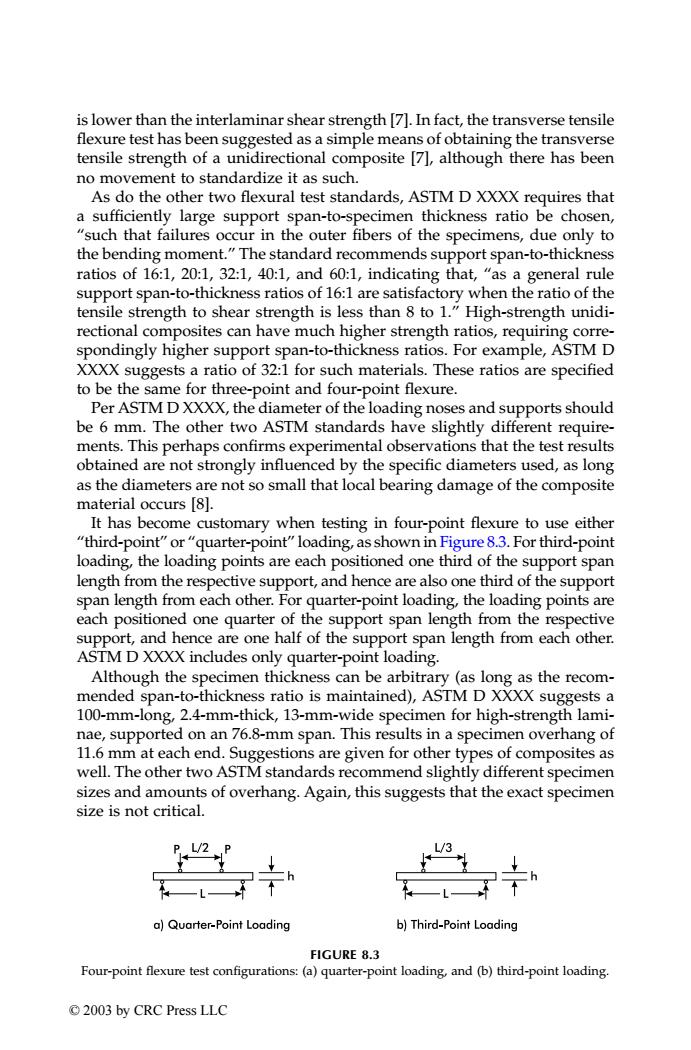正在加载图片...

is lower than the interlaminar shear strength [7].In fact,the transverse tensile flexure test has been suggested as a simple means of obtaining the transverse tensile strength of a unidirectional composite [7],although there has been no movement to standardize it as such. As do the other two flexural test standards,ASTM D XXXX requires that a sufficiently large support span-to-specimen thickness ratio be chosen, "such that failures occur in the outer fibers of the specimens,due only to the bending moment."The standard recommends support span-to-thickness ratios of 16:1,20:1,32:1,40:1,and 60:1,indicating that,"as a general rule support span-to-thickness ratios of 16:1 are satisfactory when the ratio of the tensile strength to shear strength is less than 8 to 1."High-strength unidi- rectional composites can have much higher strength ratios,requiring corre- spondingly higher support span-to-thickness ratios.For example,ASTM D XXXX suggests a ratio of 32:1 for such materials.These ratios are specified to be the same for three-point and four-point flexure. Per ASTM D XXXX,the diameter of the loading noses and supports should be 6 mm.The other two ASTM standards have slightly different require- ments.This perhaps confirms experimental observations that the test results obtained are not strongly influenced by the specific diameters used,as long as the diameters are not so small that local bearing damage of the composite material occurs [8]. It has become customary when testing in four-point flexure to use either "third-point"or"quarter-point"loading,as shown in Figure 8.3.For third-point loading,the loading points are each positioned one third of the support span length from the respective support,and hence are also one third of the support span length from each other.For quarter-point loading,the loading points are each positioned one quarter of the support span length from the respective support,and hence are one half of the support span length from each other. ASTM D XXXX includes only quarter-point loading. Although the specimen thickness can be arbitrary(as long as the recom- mended span-to-thickness ratio is maintained),ASTM D XXXX suggests a 100-mm-long,2.4-mm-thick,13-mm-wide specimen for high-strength lami- nae,supported on an 76.8-mm span.This results in a specimen overhang of 11.6 mm at each end.Suggestions are given for other types of composites as well.The other two ASTM standards recommend slightly different specimen sizes and amounts of overhang.Again,this suggests that the exact specimen size is not critical. /3 a)Quarter-Point Loading b)Third-Point Loading FIGURE 8.3 Four-point flexure test configurations:(a)quarter-point loading,and (b)third-point loading. 2003 by CRC Press LLCis lower than the interlaminar shear strength [7]. In fact, the transverse tensile flexure test has been suggested as a simple means of obtaining the transverse tensile strength of a unidirectional composite [7], although there has been no movement to standardize it as such. As do the other two flexural test standards, ASTM D XXXX requires that a sufficiently large support span-to-specimen thickness ratio be chosen, “such that failures occur in the outer fibers of the specimens, due only to the bending moment.” The standard recommends support span-to-thickness ratios of 16:1, 20:1, 32:1, 40:1, and 60:1, indicating that, “as a general rule support span-to-thickness ratios of 16:1 are satisfactory when the ratio of the tensile strength to shear strength is less than 8 to 1.” High-strength unidirectional composites can have much higher strength ratios, requiring correspondingly higher support span-to-thickness ratios. For example, ASTM D XXXX suggests a ratio of 32:1 for such materials. These ratios are specified to be the same for three-point and four-point flexure. Per ASTM D XXXX, the diameter of the loading noses and supports should be 6 mm. The other two ASTM standards have slightly different requirements. This perhaps confirms experimental observations that the test results obtained are not strongly influenced by the specific diameters used, as long as the diameters are not so small that local bearing damage of the composite material occurs [8]. It has become customary when testing in four-point flexure to use either “third-point” or “quarter-point” loading, as shown in Figure 8.3. For third-point loading, the loading points are each positioned one third of the support span length from the respective support, and hence are also one third of the support span length from each other. For quarter-point loading, the loading points are each positioned one quarter of the support span length from the respective support, and hence are one half of the support span length from each other. ASTM D XXXX includes only quarter-point loading. Although the specimen thickness can be arbitrary (as long as the recommended span-to-thickness ratio is maintained), ASTM D XXXX suggests a 100-mm-long, 2.4-mm-thick, 13-mm-wide specimen for high-strength laminae, supported on an 76.8-mm span. This results in a specimen overhang of 11.6 mm at each end. Suggestions are given for other types of composites as well. The other two ASTM standards recommend slightly different specimen sizes and amounts of overhang. Again, this suggests that the exact specimen size is not critical. FIGURE 8.3 Four-point flexure test configurations: (a) quarter-point loading, and (b) third-point loading. TX001_ch08_Frame Page 123 Saturday, September 21, 2002 4:59 AM © 2003 by CRC Press LLC